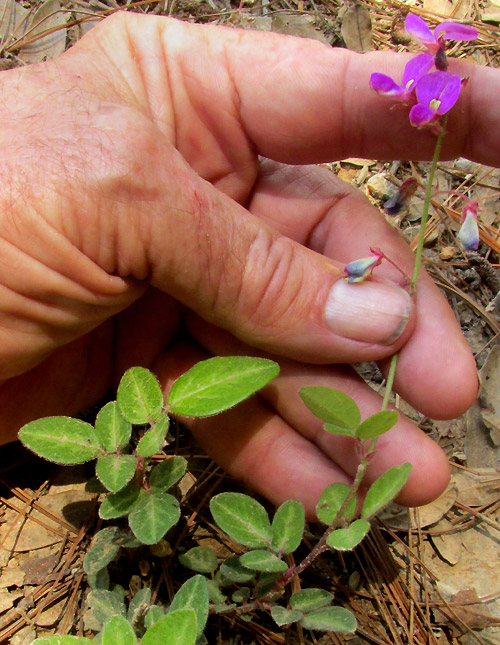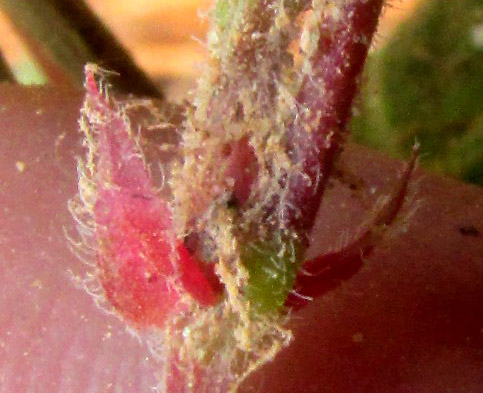Excerpts from Jim Conrad's
Naturalist Newsletter
Entry from field notes dated September 1, 2023, taken in Los Mármoles National Park in the Eastern Sierra Madre mountains, Hidalgo state, MÉXICO; forested ridge near fork in road leading to Puerto de Piedra, on road between town of Trancas {on maps designated "Morelos (Trancas)"} and Nicolás Flores; oak/pine forest on limestone bedrock; elevation ~2,300m (~7,550ft); ~N20.80°, ~W99.24°
DESMODIUM MOLLICULUM

Emerging from forest litter composed mostly of fallen pine needles and oak leaves, the small wildflower shown above, with its leaves divided into three leaflets, and its flowers shaped like those of familiar garden bean and pea plants, it was clearly a member of the big Bean Family, the Fabaceae.

The blossoms were classic papilionaceous ones, that word based on the French papillon, meaning "butterfly." Papilionaceous flowers consist of five petals, of which there's a top petal, often called the standard or banner, two separate side petals referred to as wings, and two lower petals fused along their common margin named the keel, for they are folded together to form a scoop-shaped structure, like the keel of a boat. The standard's white and yellow nectar guide is typical of many papilionaceous flowers, but from species to species, if present, they vary in size, shape and color pattern.

Bean Family papilionaceous blossoms typically produce ten stamens, which most frequently have their filaments fused into a cylindrical "staminal column" surrounding the slender style atop the ovary. Above, the blossom's wings and keel have been bent away to reveal the column topped by yellow, pollen-producing anthers. The greenish-yellow style emerges from the column and bends upward, topped by a flattish, white stigma ready to receive pollen from other flowers. Often just below the stigma the style is covered with a dense "beard" of hairs. This style lacks a beard, and that feature is helpful for deciding which genus we have.

At the right, the flower's burgundy-colored calyx tube bulges unusually at its base, and is covered with especially long, soft hairs, often enlarged into glands at their bases. It's hard to say whether certain hair tips also bear glands, but one feature of this plant's vegetative parts is that the hairs accumulate trash, giving the appearance of being dirty; sticky glandular secretions might account for that. On the leaf below, possibly the trash is largely pollen.


The above leaflets are somewhat thick, with the veins a little impressed into the tissue. Margins curve under a bit. The petiole is particularly short. At the point of attachment of the petiole with the stem, notice the two pinkish stipules. At the left is a closer look at other stipules. In Bean Family identifications, often stipules are conspicuous, and they can take many forms; stipules are good field marks. These are big ones, distinctly curved, very hairy, and pink.
The 2021 work by José Luis Villaseñor and others entitled "Riqueza y distribución de la flora vascular del estado de Hidalgo, México" reports that here in upland central Mexico's Hidalgo state the Bean Family is the second largest plant family, comprising 320 documented species. Identifying our plant was tricky because all literature I could find helpful in determining the genus heavily depended on features of the genus's distinctive, legume-type fruits. Our plant wasn't yet producing legumes. Mostly because I recognized certain familiar combinations of features suggestive of the large, often weedy genus group of plants known as the tick-trefoils, genus Desmodium, I made a lucky guess.
The "tick" in tick-trefoil refers to how the legumes of Desmodium species stick to your legs as you walk by them, like ticks. They're also called tick clover, hitchhikers, and beggar lice. The fruits latch onto cloth and fur with special hooked hairs, just like Velcro. General features on our fruitless plant suggestive of Desmodium include the leaflets-of-three, and purplish flowers clustered in pairs along an elongated inflorescence rachis. Also, among the tick-trefoils, having unusual hairs and hairiness is common, and our plants' hairiness seemed unusual.
Villaseñor and his team lists 18 Desmodium species for Hidalgo state. Here, if you have a tick-trefoil which is a ground-hugging herb with three-divided leaves, and the leaves are covered with long, soft hairs, you have DESMODIUM MOLLICULUM; there's no English name other than the general tick-trefoil and other such names.
Desmodium molliculum is widely distributed in upland oak-pine forests and dry, grassy environments from northern Mexico all the way south to Bolivia.
Pollinators visit the flowers, and herbivores such as the area's roving cattle are likely to take a chomp of it as they wander by. However, throughout its distribution area this species is best known as a medicinal herb. The online Biblioteca Digital de la Medicina Tradicional Mexicana -- which refers to the species as amor seco, or "dry love," a name used for many species -- states that in Michoacán state indigenous communities the herb is used for animal bites. First the plant is boiled in water, and the resulting tea is used to wash the bite. Then the cooked plant is toasted on a comal, a kind of griddle, then the crispy remains are ground, and the powder is daubed on the animal's bite. This is repeated daily for nine days.
The 2020 study by Karyn Olascuaga-Castillo and others entitled "Desmodium molliculum (Kunth) DC (Fabaceae); Ethnobotanical, phytochemical and pharmacological profile of a Peruvian Andean plant" came to this conclusion: "Desmodium molliculum has exhibited a wide spectrum of pharmacological activities such as healing, antiasthmatic, anti-inflammatory, hepatoprotective, antibacterial, contraceptive, antioxidant activities, among others."
On the Internet, 2 fl oz of Desmodium molliculum extract in a bottle, sold as a dietary supplement under the name of Burbur Pinella, costs a hefty US$40.00. A bag of dried flakes, sold under its Peruvian name Manauypa, costs about the same.